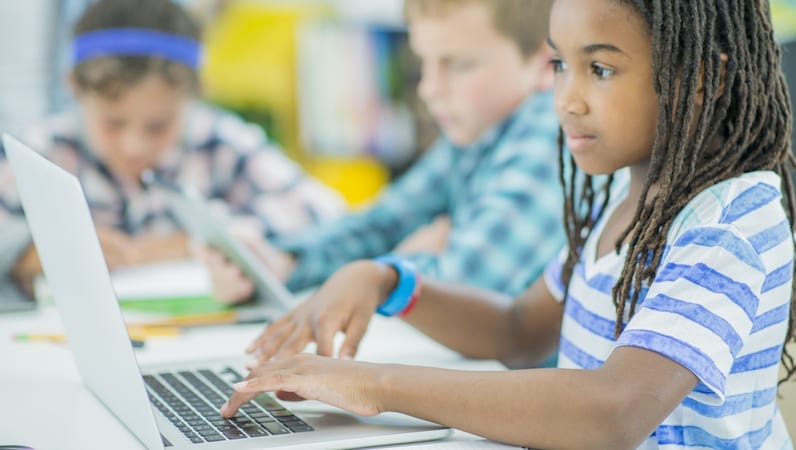When I started my current job two years ago at a 1:1 school, I believed laptops were going to transform the way my students learn and how I teach. It turns out it wasn’t so simple. At the beginning of the year, we jumped right in, and I had them use their laptops to create websites and market ideas to an outside audience. We would take the English content we covered in class and apply it in a way that was authentic and exciting for my students!
But then, static.
My students stared blankly at their screens, unsure of what to do next. I had made the assumption about the so-called tech generation: Surely they know everything about computers. I assumed that Facebook, Instagram, Snapchat, and iPhones are preparing them for a technology-centered career world. Unfortunately, that couldn’t be further from the truth. So much of their time using laptops in school is just spent word processing, sending emails, or weighing down their backpacks. It’s our job to get students ready for increasingly tech-savvy jobs. We need to provide students with opportunities to use laptops and other devices in ways that build their skills. Here are five ways school laptops can positively impact student learning if used correctly.
1. Use school laptops to create movies.

No, students don’t just have to watch movies—they can make them! Having laptops in the classroom allows students to bring course material to life. For instance, in English class, students can create a visual representation of a novel they’re reading and put their own spin on the plot. Or why not have students film their experiments in science class to show everyone the magic of learning? Have students recreate iconic scenes from history that they are exploring. It doesn’t matter if you use iMovie, Windows Movie Maker, or free online software, students will love showcasing their learning by making a movie.
2. Make presentations come alive.

When students have access to laptops in the classroom, they can take their presentations to the next level. Currently, my students have access to iMovie, iBooks Author, the Adobe Suite, SketchUp, GarageBand, and so much more. This is thousands of dollars worth of software waiting to be used. It would be a waste not to let them use it!
I recently asked my students to write a piece of satire inspired by the novel we are reading. One musically talented student wanted to write a song parody. She wrote the lyrics, and I encouraged her to take it to the next level: Sing and produce the song. Using GarageBand, she put everything together into a wonderful project and even uploaded her song to YouTube. Another student wanted to write a poem. When she was finished writing it, she took all of her poetry and used the e-pub extension on Apple Pages to create an e-book. These students produced polished, professional-looking products. And they learned the content and valuable 21st-century skills.
3. Utilize the Internet for deeper learning.

I don’t know if there is anything better than when students start geeking out over the content. During a philosophy unit, I was talking to my class about paradoxes. My plan was to familiarize them with the concept, explain a couple of the popular ones, and then move on to another concept. However, my students were so captivated by the paradoxical problems that they wanted to dig deeper and research more. What began as a 20-minute lesson turned into a two-day mini-research unit complete with students presenting their findings to the class.
When you have laptops in the classroom, students have the capability to take content and go further with it. This could be with single lessons, entire units, or even in-depth SAT practices on Khan Academy. Students struggling with finding correlation coefficients, for example, could use laptops to get more practice. Whatever is being covered in class, students can use their laptop to work independently and research more if they need to or if they are excited about the content.
4. Learning does not stop when they leave school.

When used correctly, school laptops give your students lots of opportunities to learn and review. Ever pick up an advanced algebra book, look at the pages and say, “Oh, now I get it!”? Of course not! That’s why our best teachers are in those classrooms day after day breaking it down for students. But what happens when a student misses something or was absent? Using a document camera, like Image Mate, or online services like Screencastify, teachers can record their lectures and upload them to their online classroom so that students have access to the information 24-7.
5. Use school laptops to check for understanding.

Ever wonder if students are actually learning anything? (I hope you answered yes.) By using laptops, you can perform simple checks for understanding and get immediate feedback. No paper, no grading. Just use Google Forms, Edulastic, or Kahoot! to see exactly where your students are so you can reteach, move on, or know which students to pull for small groups. Technology can make assessments truly formative, as the data is instant and educators can react accordingly.

At the end of the day, we can’t just expect students to start finding new and creative ways to use their laptops in the classroom. When used just for word processing or to check email, school laptops are simply substitutes for a pen and paper. However, when used to their full potential, these machines can help take learning to the next level.
Join the great conversations going on about school leadership in our Facebook groups at Principal Life and High School Principal Life.
Plus, check out this article about flipped classrooms.

